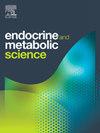左旋肉碱对肝细胞培养中胆汁酸诱导的线粒体功能障碍和IGF-1损伤具有保护作用
Q3 Medicine
引用次数: 0
摘要
背景和目的过量的胆汁酸(ΒΑ)会产生肝毒性作用。我们研究了糖鹅脱氧胆酸(GCDC)对肝细胞线粒体功能和胰岛素样生长因子-1 (IGF-1)活性的影响,并研究了左旋肉碱(CRNT)是否具有任何保护作用。方法用0 ~ 100 μM GCDC加或不加5 mM左旋肉碱(CRNT)处理原代肝细胞。采用溴脱氧尿苷掺入法测定DNA合成。测定肝细胞匀浆中肉碱棕榈酰基转移酶-1 (CPT-1)、细胞色素c氧化酶(CcO)和中链酰基辅酶a脱氢酶(MCAD)的酶活性。RT- PCR和Western blot分别检测过氧化物酶体增殖物激活受体γ辅助激活因子1-α (PGC-1α)和IGF-1受体(IGF-1R)的表达。结果GCDC治疗可显著降低MCAD、CPT-1和CcO的酶活性(P <;0.01),线粒体ATP含量。此外,GCDC显著增加线粒体中丙二醛(MDA)水平,下调PGC-1α (p <;0.01)。此外,在gcdc处理的肝细胞中,igf -1诱导的DNA合成和IGF-1R基因表达也显著降低。然而,与5 mM CRNT共处理可明显消除gcd诱导的CcO活性损伤和PGC-1α下调,而对MCAD活性没有影响。此外,CRNT处理还恢复了gcdc处理的肝细胞中CPT-1的酶活性和IGF-1的基因表达水平(p <;0.05)。结论线粒体功能障碍和IGF-1活性损伤可触发sgcdc诱导的肝毒性作用。除了上调PGC-1α和IGF-1R外,CRNT还通过增强CPT-1和CcO酶活性,以及ATP的产生,对ΒΑ-induced细胞毒性具有潜在的有益作用。本文章由计算机程序翻译,如有差异,请以英文原文为准。
l-carnitine protects against bile acid-induced mitochondrial dysfunction and IGF-1 impairment in hepatocyte cultures
Background and aims
Excessive amounts of bile acids (ΒΑ) exert hepatotoxic effects. We investigated the effects of glycochenodeoxycholic acid (GCDC) on mitochondrial function and insulin-like growth factor-1 (IGF-1) activity in hepatocytes and also examined if l-carnitine (CRNT) has any protective role.
Methods
Primary hepatocyte cultures were treated with 0–100 μM GCDC with or without 5 mM l-carnitine (CRNT). DNA synthesis was measured by bromodeoxyuridine incorporation assay. Enzymic activities of carnitine palmitoyltransferase-1 (CPT-1), cytochrome c oxidase (CcO) and medium chain-acylCoA dehydrogenase (MCAD), were measured in hepatocyte homogenates. Expression of peroxisome proliferator activated receptor gamma coactivator 1-α (PGC-1α) and IGF-1 receptor (IGF-1R) was detected by RT- PCR and Western blot analysis, respectively.
Results
Treatment with GCDC significantly decreased the enzymatic activity of MCAD, CPT-1 and CcO (P < 0.01), and mitochondrial ATP content. Additionally, GCDC significantly increased malondialdehyde (MDA) levels in mitochondria and downregulated PGC-1α (p < 0.01). Furthermore, the IGF-1-induced DNA synthesis and IGF-1R gene expression were also notably reduced in GCDC-treated hepatocytes. However, co-treatment with 5 mM CRNT markedly abrogated the GCDC-induced impairment of CcO activity and PGC-1α downregulation, while it had no effect on MCAD activity. In addition, CRNT treatment also restored the enzymatic activity of CPT-1 and the gene expression levels of IGF-1 in GCDC-treated hepatocytes (p < 0.05).
Conclusions
GCDC-induced hepatotoxic effects could be triggered by mitochondrial dysfunction and impairment of IGF-1 activity. CRNT has potential beneficial effects against ΒΑ-induced cytotoxicity via enhancing the CPT-1 and CcO enzyme activities, and ATP production in addition to upregulation of PGC-1α and IGF-1R.
求助全文
通过发布文献求助,成功后即可免费获取论文全文。
去求助
来源期刊

Endocrine and Metabolic Science
Medicine-Endocrinology, Diabetes and Metabolism
CiteScore
2.80
自引率
0.00%
发文量
4
审稿时长
84 days
 求助内容:
求助内容: 应助结果提醒方式:
应助结果提醒方式:


